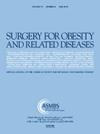接受减肥手术妇女的妊娠和分娩并发症:袖式胃切除术与Roux-en-Y胃旁路术
IF 3.5
3区 医学
Q1 SURGERY
引用次数: 0
摘要
背景:代谢减肥手术是治疗严重肥胖最有效的方法,严重肥胖影响数百万人的健康,其中大多数是育龄妇女。Roux-en-Y胃旁路手术(RYGB)和袖胃切除术(SG)是最常见的减肥手术,与持久的体重减轻和合并症的解决有关。虽然产科结果普遍改善,但比较RYGB和SG对产科结果的影响的安全性尚未得到充分探讨。目的:比较rygb和SG后分娩的妇女的产科结局,以确定围产期结局是否存在差异。环境:美国,商业、医疗保险、医疗补助、政府和现金支付系统内的所有患者。方法:PearlDiver-Mariner数据库用于识别在2010年至2020年期间接受RYGB或SG手术并在2年内怀孕的18-52岁女性。结果定义为出现1种或1种以上妊娠相关并发症,包括妊娠糖尿病、先兆子痫和子宫切除术。进行1:1倾向匹配分析。结果:共16911例,10675例(63.1%)和6236例(36.9%)分别接受了SG和RYGB治疗。SG组的产科并发症发生率为28.3%,而RYGB组为32.1% (P < 0.01)。与SG组相比,RYGB组发生产科并发症的相对几率增加(优势比1.26;95%置信区间1.14-1.38)。结论:虽然两者都是安全的,但RYGB的产科并发症发生率高于SG。这些发现可以帮助妇女和外科医生决定采用哪种手术,并为手术后怀孕时间的讨论提供信息。本文章由计算机程序翻译,如有差异,请以英文原文为准。
Pregnancy and birth complications among women undergoing bariatric surgery: sleeve gastrectomy versus Roux-en-Y gastric bypass
Background
Metabolic bariatric surgery is the most effective therapy for severe obesity, which affects the health of millions, most of whom are women of child-bearing age. Roux-en-Y gastric bypass (RYGB) and sleeve gastrectomy (SG) are the most common bariatric procedures and are associated with durable weight loss and comorbidity resolution. Although obstetric outcomes broadly improve, the safety profile comparing the impact of RYGB and SG on obstetric outcomes is underexplored.
Objectives
To compare obstetric outcomes in women who gave birth post-RYGB versus SG to determine whether there are differences in perinatal outcomes.
Setting
United States, all patients within commercial, Medicare, Medicaid, government, and cash payor systems.
Methods
The PearlDiver-Mariner database was used to identify women aged 18–52 years who underwent RYGB or SG between 2010 and 2020 and became pregnant within 2 years of surgery. Outcomes were defined by the presence of 1 or more pregnancy-related complications including gestational diabetes, preeclampsia, and hysterectomy. A 1:1 propensity-matched analysis was performed.
Results
In total, 16,911 individuals, 10,675 (63.1%) and 6236 (36.9%) underwent SG and RYGB, respectively. Obstetric complication rates were 28.3% in the SG versus 32.1% in the RYGB group (P < .01). The RYGB group had an increased relative odds of experiencing an obstetric complication compared with the SG group (odds ratio 1.26; 95% confidence interval 1.14–1.38).
Conclusions
Although both are safe, RYGB was associated with a greater obstetric complication rate than SG. These findings can help women and surgeons decide which procedure to pursue and inform discussions regarding the timing of pregnancy after surgery.
求助全文
通过发布文献求助,成功后即可免费获取论文全文。
去求助
来源期刊
CiteScore
6.70
自引率
12.90%
发文量
570
审稿时长
56 days
期刊介绍:
Surgery for Obesity and Related Diseases (SOARD), The Official Journal of the American Society for Metabolic and Bariatric Surgery (ASMBS) and the Brazilian Society for Bariatric Surgery, is an international journal devoted to the publication of peer-reviewed manuscripts of the highest quality with objective data regarding techniques for the treatment of severe obesity. Articles document the effects of surgically induced weight loss on obesity physiological, psychiatric and social co-morbidities.

 求助内容:
求助内容: 应助结果提醒方式:
应助结果提醒方式:


